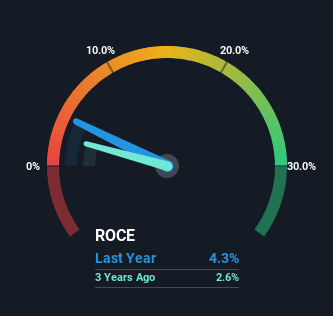- Australia
- /
- Commercial Services
- /
- ASX:DOW
Downer EDI (ASX:DOW) Has Some Way To Go To Become A Multi-Bagger
If we want to find a stock that could multiply over the long term, what are the underlying trends we should look for? Amongst other things, we'll want to see two things; firstly, a growing return on capital employed (ROCE) and secondly, an expansion in the company's amount of capital employed. Put simply, these types of businesses are compounding machines, meaning they are continually reinvesting their earnings at ever-higher rates of return. However, after briefly looking over the numbers, we don't think Downer EDI (ASX:DOW) has the makings of a multi-bagger going forward, but let's have a look at why that may be.
What Is Return On Capital Employed (ROCE)?
For those who don't know, ROCE is a measure of a company's yearly pre-tax profit (its return), relative to the capital employed in the business. The formula for this calculation on Downer EDI is:
Return on Capital Employed = Earnings Before Interest and Tax (EBIT) ÷ (Total Assets - Current Liabilities)
0.043 = AU$193m ÷ (AU$7.3b - AU$2.9b) (Based on the trailing twelve months to June 2023).
Thus, Downer EDI has an ROCE of 4.3%. In absolute terms, that's a low return and it also under-performs the Commercial Services industry average of 7.4%.
See our latest analysis for Downer EDI

In the above chart we have measured Downer EDI's prior ROCE against its prior performance, but the future is arguably more important. If you'd like to see what analysts are forecasting going forward, you should check out our free report for Downer EDI.
So How Is Downer EDI's ROCE Trending?
Over the past five years, Downer EDI's ROCE and capital employed have both remained mostly flat. This tells us the company isn't reinvesting in itself, so it's plausible that it's past the growth phase. So don't be surprised if Downer EDI doesn't end up being a multi-bagger in a few years time. On top of that you'll notice that Downer EDI has been paying out a large portion (64%) of earnings in the form of dividends to shareholders. Most shareholders probably know this and own the stock for its dividend.
The Bottom Line
We can conclude that in regards to Downer EDI's returns on capital employed and the trends, there isn't much change to report on. And in the last five years, the stock has given away 33% so the market doesn't look too hopeful on these trends strengthening any time soon. On the whole, we aren't too inspired by the underlying trends and we think there may be better chances of finding a multi-bagger elsewhere.
Downer EDI does have some risks though, and we've spotted 1 warning sign for Downer EDI that you might be interested in.
While Downer EDI isn't earning the highest return, check out this free list of companies that are earning high returns on equity with solid balance sheets.
New: Manage All Your Stock Portfolios in One Place
We've created the ultimate portfolio companion for stock investors, and it's free.
• Connect an unlimited number of Portfolios and see your total in one currency
• Be alerted to new Warning Signs or Risks via email or mobile
• Track the Fair Value of your stocks
Have feedback on this article? Concerned about the content? Get in touch with us directly. Alternatively, email editorial-team (at) simplywallst.com.
This article by Simply Wall St is general in nature. We provide commentary based on historical data and analyst forecasts only using an unbiased methodology and our articles are not intended to be financial advice. It does not constitute a recommendation to buy or sell any stock, and does not take account of your objectives, or your financial situation. We aim to bring you long-term focused analysis driven by fundamental data. Note that our analysis may not factor in the latest price-sensitive company announcements or qualitative material. Simply Wall St has no position in any stocks mentioned.
About ASX:DOW
Downer EDI
Operates as an integrated facilities management services provider in Australia, New Zealand, and internationally.
Excellent balance sheet with proven track record.
Similar Companies
Market Insights
Community Narratives



